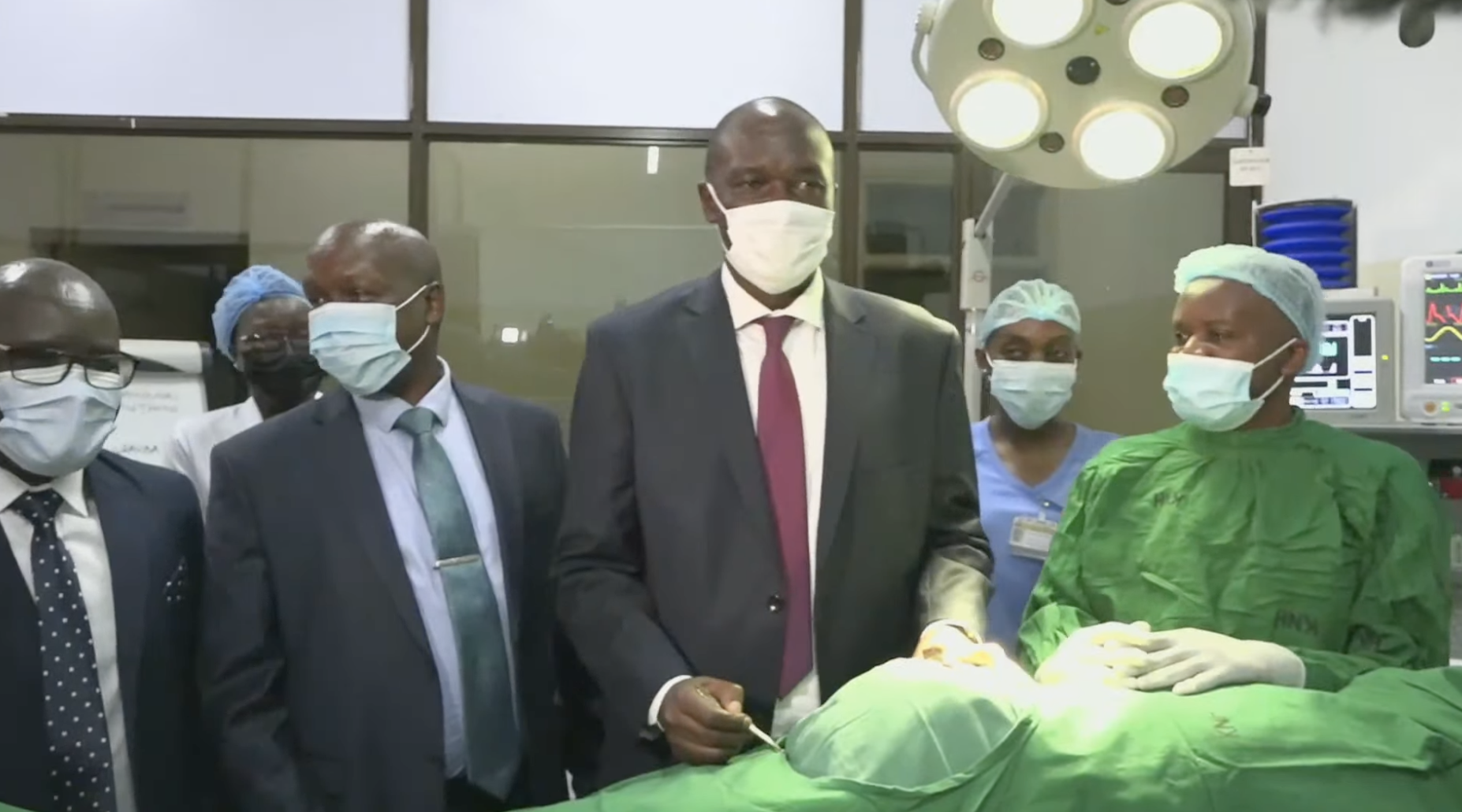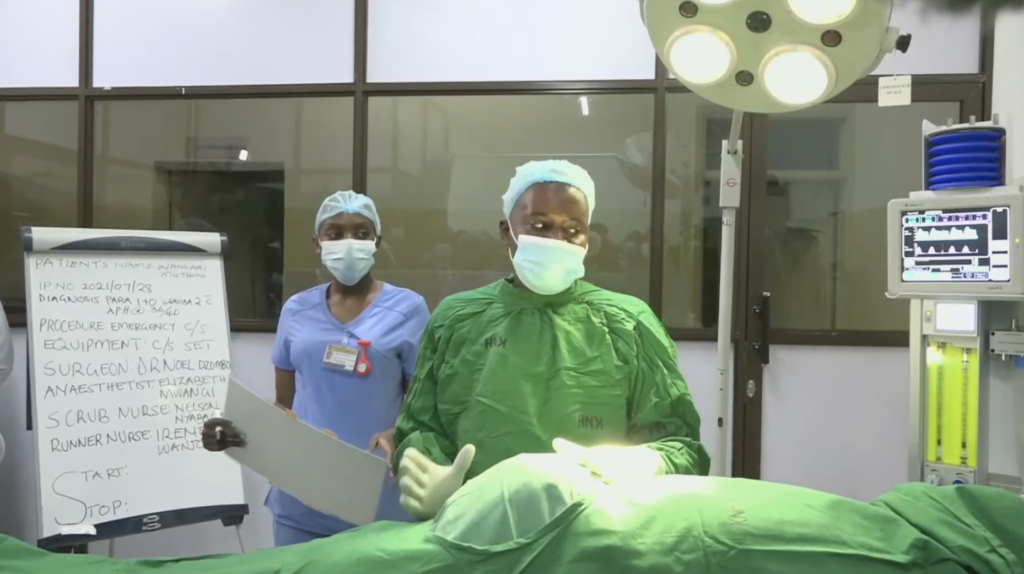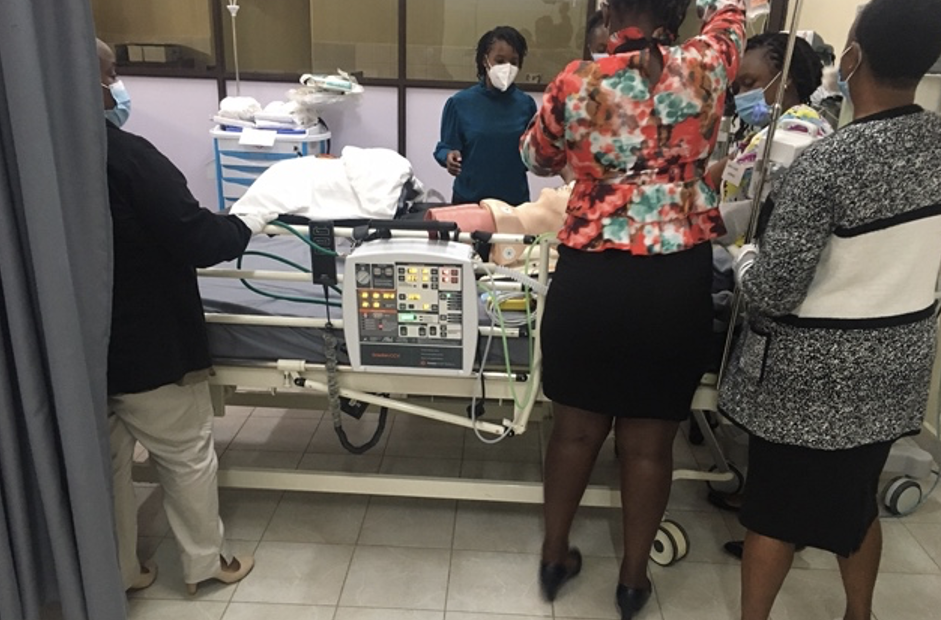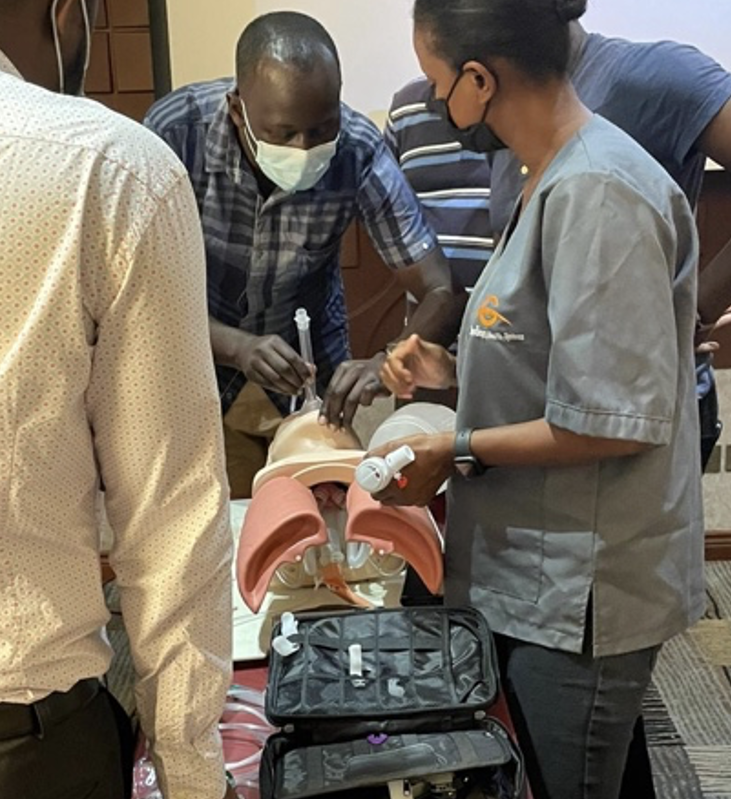
Kenya Ministry of Health, Kenya Medical Training College, and Gradian Health Systems Partner to Launch Anesthesia and Critical Care Simulation Lab
Lab Becomes First-of-Its-Kind Facility at a Public Medical Training Institution in Kenya


Lab Becomes First-of-Its-Kind Facility at a Public Medical Training Institution in Kenya

The Kenya Ministry of Health, Kenya Medical Training College, and Gradian Health Systems have partnered to launch a state-of-the-art medical simulation laboratory to provide the East African nation’s anesthesia and critical care workforce more safe learning environments in which to strengthen the skills to care for patients.
“The laboratory being launched … is the first of its kind in a public medical school in Kenya,” heralded MOH Permanent Secretary Susan Mochache, in a speech delivered by Director-General for Health Dr. Patrick Amoth on her behalf at the lab’s launch ceremony on July 28, 2021. “[It is] an innovation which will define the direction that KMTC will be taking in enhancing healthcare training in the country.”
Located at KMTC’s Nairobi campus, the sim lab is intended to help healthcare providers and medical students strengthen clinical and non-clinical skills by practicing real-life patient scenarios under the supervision of instructors and physicians.
Simulation-based training has long been a proven method for improving healthcare provider skills and patient care—especially in anesthesia and critical care. Anesthesia is necessary for any surgical procedure we undertake across our lives and critical care is the range of care we need when faced with life-threatening injuries or illnesses. Even though these are ever-present needs in any healthcare system, the coronavirus pandemic has drawn renewed attention to the role anesthesia and critical care services play in the management of the most severe COVID-19 patients.
“Simulation is the way to go,” said Dr. Wagaki Gicheru, the KMTC Coordinator of E-Learning Services.
“Simulation is the way to go,” said Dr. Wagaki Gicheru, the KMTC Coordinator of E-Learning Services who lead the creation of the sim lab for KMTC. “This is the way for us to innovate for ourselves, and allow for our trainees to experience and utilize their skills in a controlled environment [and] … be immersed in a real-life environment so they can be able to understand the decisions they make in a clinical environment.”
Creating a High-Fidelity Clinical Setting for Safe & Effective Learning
The two-room simulation lab includes a mock ICU and operating theater in which routine and complex clinical cases can be performed under the guidance of clinical trainers. Medical equipment and supplies—like the Gradian CCV (Comprehensive Care Ventilator), the Gradian UAM (Universal Anaesthesia Machine), mannikins, an ICU bed, patient monitors, oxygen cylinders and accessories, machines to simulate different types of breathing, airway kits, and other devices, accessories, and consumables—help simulate real-life scenarios, such
 as learning how to successfully transport a patient under mechanical ventilation from an operating theatre to the ICU. In addition, the lab includes a classroom set up for lectures and debriefs as well as a full audio-visual suite that allow higher numbers of trainees—including students based at other KMTC campuses—to observe simulation scenarios as they are being performed.
as learning how to successfully transport a patient under mechanical ventilation from an operating theatre to the ICU. In addition, the lab includes a classroom set up for lectures and debriefs as well as a full audio-visual suite that allow higher numbers of trainees—including students based at other KMTC campuses—to observe simulation scenarios as they are being performed.
The simulation lab can both help support the growth of the anesthesia and critical care workforce as well as how clinicians work—individually and together—to provide care.
“Increasing the number of trained personnel is a painstaking process,” said PS Mochache. “For example, to train a critical care nurse, it takes 18 months. It is envisioned that the training of general nurses and medical personnel in anesthesia, critical, and emergency care skills using the simulation laboratory will accelerate the process of addressing the existing acute shortages of health workforce and improve the healthcare worker staffing ratios.”
In addition, Gicheru highlighted how a high-fidelity learning environment can help teams of clinicians work together more effectively as well as practice non-clinical skills like decision making, teamwork, and communication.
“At KMTC, we have various cadres that we train, and many of the times we train them in a compartmentalized way: nurses by themselves, clinical officers by themselves. … We see the opportunity that has been provided by our simulation lab because it allows all teams who are caring for critical care patients or providing anesthesia to work together and simulate together so interpersonal training is a thing that is enhancing an understanding of interpersonal roles in patient care.”
Building Upon Critical Care Investments for Pandemic Response
In addition to helping support Kenya’s medical education infrastructure, the simulation lab is also one of a set of investments focused on strengthening the nation’s critical care services. In 2020—in response to the COVID-19 pandemic—the Government of Kenya partnered with Gradian Health Systems and the World Bank to supply 100 Gradian Comprehensive Care Ventilators (CCVs) to increase access to critical care and mechanical ventilation during the pandemic and in the future.

Ventilators are recognized as a critical tool in managing severe coronavirus cases and are classified as priority medical devices for COVID-19 by the World Health Organization.
With it 21 hours of battery power and the ability to use any source of oxygen—including room air and oxygen concentrators—the Gradian CCV allows clinical teams to maximize limited resources and
function in a wide variety of settings including those with unreliable access to oxygen or electricity. It also combines the key aspects of specialized ICU ventilators, transport ventilators, and sub-acute care ventilators into one versatile and portable device, enabling use cases that have traditionally required multiple pieces of equipment.
To date, Gradian CCVs have been installed in more than 24 hospitals of varying levels—ranging from national, university, regional, to level 4 hospitals—in 19 counties. In addition, Gradian’s network of clinical trainers have trained 345 healthcare providers on product use and clinical refresher topics as well as nearly 50 biomedical technicians in these hospitals on machine maintenance.
“For us, this training is a requirement. It’s not a perk or an added bonus. It is something we’re responsible for so our equipment is used effectively and safely,” said Gradian CEO Lina Sayed at the launch ceremony, referencing Gradian’s model of dependable and easy-to-access technical support and high-quality training for providers.
“For us, this training is a requirement. It’s not a perk or an added bonus,” Gradian Health Systems CEO Lina Sayed.
Partnering with Professional Societies to Provide Critical Care Training to Hospital Teams
While officially launched last month, the sim lab has since February 2020 been used to conduct critical care trainings for hospitals teams that are using the Gradian CCV, as part of a special partnership among the Kenya Society of Anesthesiologists (KSA), the Critical Care Society of Kenya (CCSK), and Gradian to support the operationalization of ICUs and anesthesia services. Under the joint effort—which has also been supported by the ELMA Relief Foundation and UBS Optimus Foundation—more than 200 providers from 18 hospitals, such as Nanyuki Level 5 Hospital, Othaya Level 6 Hospital, Pumwani Maternity Hospital, and Tigoni Level 4 Hospital, have been trained.
While the majority of trainees have been nurses, the training cohorts also include clinical and medical officers, nutritionists, obstetricians and gynecologists, pediatricians, physicians, and surgeons representing various units, such as COVID-19 centers, critical care units, emergency departments, and operating theatres.

The two-day trainings—which also occurred on-site at hospitals and other centralized locations and are still ongoing—feature overviews of the Gradian CCV and principles of mechanical ventilation before participating in simulated scenarios involving topics such as airway management, setting ventilator modes, and troubleshooting the ventilator. On day two, participants practice scenarios they themselves develop, debrief on learnings, and identify team-specific goals to achieve in the following months together at their hospitals. Some of the goals identified by trainee teams include expanding use of the Gradian CCV to patient transfer in addition to ICU use; using the CCV for non-invasive ventilation in a COVID-19 center; triaging an adult patient with COVID-19; providing acute management of burns in child; managing a patient with a severe head injury with respiratory failure; increasing the number of clinicians at their facility who can use the CCV safely; and conducting monthly simulation scenarios and teaching sessions by hospital departments to increase skills.
The training also includes instruction on how trainees can use the Basic Principles of Critical Care Course—a new comprehensive course developed by KSA and CCSK with support from Gradian—that serves as a refresher for ICU nurses and medical officers. The course—which is free and available to all on the online Gradian Training Resource Center—covers the core concepts of critical care from pain management to total nursing care to nutritional support to documentation. This course’s modular design is also intended to help working teams focus on their specific areas of growth in a more targeted manner.
“The curriculum that was developed by KSA and CCSK … was designed in a modular way so that each hospital can be able to pick an area where they have a weakness and can be able to help themselves,” according to Gradian Managing Director Kenneth Otieno, adding that KSA and CCSK paired specific clinical trainers with hospitals teams based on their needs.
Strengthening Simulation-Based Training Infrastructure Across the Country and Region
 The KMTC sim lab was designed based on learnings from Gradian’s experience establishing similar training facilities at top-training institutions across East Africa. Gradian has partnered with six universities across Tanzania and Rwanda, including University of Global Health Equity, Muhimbili University of Health and Allied Sciences, Kilimanjaro Christian Medical Centre, and Bugando Medical Centre. The design of these simulation labs is informed by Gradian’s experience employing rapid-cycle, deliberate practice, a simulation-based instructional strategy pioneered by Johns Hopkins University, in our trainings as well as years of experience gleaned from successfully conducting simulation training in a range of environments—from well-equipped university classroom settings to healthcare facilities where mobile simulation equipment is needed to fill the gaps.
The KMTC sim lab was designed based on learnings from Gradian’s experience establishing similar training facilities at top-training institutions across East Africa. Gradian has partnered with six universities across Tanzania and Rwanda, including University of Global Health Equity, Muhimbili University of Health and Allied Sciences, Kilimanjaro Christian Medical Centre, and Bugando Medical Centre. The design of these simulation labs is informed by Gradian’s experience employing rapid-cycle, deliberate practice, a simulation-based instructional strategy pioneered by Johns Hopkins University, in our trainings as well as years of experience gleaned from successfully conducting simulation training in a range of environments—from well-equipped university classroom settings to healthcare facilities where mobile simulation equipment is needed to fill the gaps.
In addition, training KMTC faculty to best leverage simulation training methodology and the high-fidelity environment has been a collaborative effort that has built upon the existing base of simulation training in Kenya.
Specifically, Gradian supported 17 faculty members from nine KMTC campuses to participate in a workshop at Kijabe Hospital on conducting training using simulation-based practices, with simulation practitioners from Kijabe as well as the University of Nairobi.
“Gradian specializes in working in healthcare facilities with new or growing anesthesia and critical care capacity and recognizes the difficulty of establishing a complex specialty like critical care in any health system,” said Otieno. “Our experience shows that investments in anesthesia and critical care equipment can only lead to improved services if balanced by long-term and strategic investments in workforce development, and we’re committed to staying a long-term partner for all East African and Kenyan healthcare providers to not just provide support through the challenges of COVID-19 but to help build resilience for the future.”